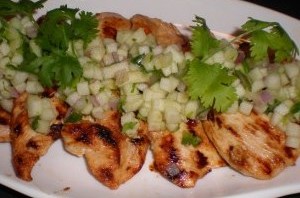On Tuesday night, I hosted a large Passover seder at my home in Jackson, Mississippi. Out of love for this Jewish dinner party, I may have opened my big mouth—then, inevitability, my door—to a few too many friends.
I realized this seder would be different as I prepared the
charoset
. Ever since I was old enough to wield a knife, I have been the one to slowly hand chop apples and walnuts for our family seder. It’s cathartic for me to count down the apples, add lemon juice so the apples won’t brown, and stir in the honey with my hands. After about two minutes of chopping, though, I realized my stack of apples was taller than usual; they went straight into the food processor – and this year, convenience trumped tradition, resulting in charoset with more liquid than usual.
Yikes! Why was I compromising my usual charoset consistency? Because I was too excited about sharing Passover, and ended up inviting 30 people for seder. And no, these weren’t just Jews who needed a place to go, I had 13 seder virgins! I chose to invite my non-Jewish friends and neighbors because most of them didn’t grow up in places with a significant Jewish population and had never been invited to help celebrate Passover. In fact, many of my guests don’t know many Jewish people besides, other than myself and other members of the ISJL staff.

We went through the seder with some moments of quiet reflection, and some of laughter and levity. I encouraged guests to read along with the Hebrew transliteration, and my heart swelled when everyone’s voices joined together for “Go Down Moses.” We had a surprisingly successful gefilte fish tasting, sang a song about the afikomen to the tune of “Oklahoma” and answered a lot of questions about matzah.
Was it the most traditional or religious seder? No, not by any means. But I made that clear to my guests and encouraged them to take home the haggadahs to study up for next year. But even with soggier charoset, I’m glad that I was able to provide some of my guests their first Jewish seder experience.
I enjoy having my home filled with friends and food, so it’s understandable why I got so excited about hosting a Passover seder. It’s a tradition that lends itself to bringing people into your house and sharing a meal that’s interactive, educational and delicious. I’m already planning for next year—with a tent outside!—and you are all invited.
seder
Pronounced: SAY-der, Origin: Hebrew, literally “order”; usually used to describe the ceremonial meal and telling of the Passover story on the first two nights of Passover. (In Israel, Jews have a seder only on the first night of Passover.)


